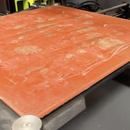Introduction: CUT THE CORD Soldering Activity
One of the biggest causes for clutter in my middle school maker space are wires, wires everywhere! Whether it be wires for machines, computers, power cords, or Chromebook chargers, its like I'm constantly being strangled by medusa herself. For many of these simple situations, I feel as though I have mastered the art of inconspicuous zip tying.
But as any teacher knows, areas that students come to contact with is often one of the more cluttered spaces and solutions must be robust and permanent. I have a set of USB mice that we use when learning CAD software on our Chromebooks and the cords were all too long (10 or 12 feet I believe). To start, I tried zip tying or even heat shrinking bunched sections of the cords to be only 2' or 3'.....this lasted a marking period.
So for my introduction to soldering lesson in my 8th grade circuits unit, I decided we would learn how to solder by cutting, shortening, and soldering all 30 USB mice in my classroom rather than headphones like we normally do each semester. This was to not only teaching the fundamentals of soldering and repairing wires in circuits, but also to declutter and better organize this workspace. Check out the attached "CUT THE CORD CHALLENGE" handout that each group of students got to guide them through this challenge. I will also outline each step of the challenge brief in this Instructable.
While I demonstrate how to cut and shorten USB cables in this Instructable, the same concept could be applied to any cord whether it is too long or broken. This is an extreme....and permanent way to declutter the mess of wires in your workspace.
Before moving forward, it is crucial that I discuss safety with soldering, especially teaching soldering to students. Before starting this challenge, all of my students learned the operational procedures for using a soldering iron, as well as the necessary precautions that must be taken (safety glasses, fume extractors, washing hands, etc). After completing the training together as a group, students must pass ITEEA's safety quiz to demonstrate they are ready to use the tool.
Step 1: Measure and Cut Out a Section
The first step is to measure and cut out a section of wire. Now to keep this more organized, I instructed each of my groups (students working in groups of 2 or 3) to cut a 12" section of wire out from either the USB end or MOUSE end of the mouse.
As I taught 5 sections of this course (about 25 students in each), I needed to cut and shorten the mice twice in order to provide each student with the soldering experience. Every mouse was assigned to two groups, one group working from the USB end and the other from the MOUSE end. Really, each mouse could have had a 24" section removed rather than two 12" sections if this wasn't a constraint.
Instructions for this step are:
- Measure 10" from the assigned side of your mouse (USB OR MOUSE)
- Cut the usb cord using wire cutters
- From the cut, measure out a 12" piece of wire
- Cut off a 12" section of wire
Step 2: Remove Outer Insulation
For this step, use wire strippers to remove the outer insulation of the cord. This will expose the wires and insulation within. Some mice may have silver or blue foil wrapped around the wires under the outer insulation, carefully peel off this foil to expose the wires within.
Instructions for this step:
- Using wire strippers, remove a 3/4" to 1" section of insulation from both the USB and MOUSE sections of wire
- IF APPLICABLE, use scissors to carefully cut away any foil insulation and threaded string wrapped around the wires within
Step 3: Place Outer Heat Shrink Tubing
This step is crucial and often forgotten. Before stripping, connecting, and soldering the wires together, place outer heat shrink tubing over the usb cord and slide it far out of the way. This will be used to seal the cord after all soldering is done, but must be installed before any connections are made.
Instructions for this step:
- BEFORE BEGINNING TO CONNECT WIRES, place a 2.5"-3" section of heat shrink tubing over one half of the cord
- Slide it far out of the way so it doesn't slide off, or shrink from the heat while soldering
Step 4: Assign Wire Roles
As previously mentioned, I had students working in groups so they each soldered one or two wires. Every USB mouse has four wires (red, black, white, green) and sometimes an additional exposed copper group wire.
Step 5: Prep Individual Wires for Soldering
Before soldering, each wire must be prepped. From this point on, students were responsible for their assigned wire to complete each of these steps. All wires can be stripped before soldering, but I highly recommend that heat shrink is installed on each wire just before it is soldered. If all four pieces of heat shrink are installed, the soldering begins, it is very likely that the heat shrink will shrink too soon or slide off.
Instructions for this step:
- Remove a small piece (1/8" to 1/4") of color insulation off each wire on both halves of the mouse cord
- Retrieve a small piece of heat shrink tubing (1/2") and slide it over one half of the connector wire, not both
- Tightly twist and raid the two halves of the wire together
- MAKE SURE THE HEAT SHRINK IS ON THE WIRE BEFORE SOLDERING
Step 6: Solder the Wires Together
In this step, the wires that have been twisted together are to be soldered together. Before soldering, ensure the heat shrink is installed over the wires the are to be soldered, and slid out of the way of where soldering is to take place. All other wires should be pushed out of the way.
Remember soldering safety guidelines and procedures before and during this step.
Instructions for this step:
- At the solder station, solder the two halves together using proper safety procedures
- Remember to apply heat first for 3 seconds, then add solder
- Be careful not to put on too much solder, the heat shrink will not slide over the soldered joint
- Be careful not to accidentally heat up the heat shrink too soon, it will not slide over the soldered joint
Step 7: Cover the Soldered Connection With Heat Shrink
After completing a single solder joint, slide the heat shrink tubing over the soldered connection. Using a heat gun, carefully and evenly heat the shrink tubing so it is tightly sealed around the wire. Ensure no exposed metal wire is showing on either end of the shrink tubing.
Instructions for this step:
- After soldering, slide the section of heat shrink over the soldered connection
- Using the heat gun, evenly heat the heat shrink tubing until it seals a tight connection
Step 8: Repeat Steps 5-7 Per Wire
Now, repeat the following steps for each of the four color wires (and copper wire if applicable).
STEP 5 - Prep wire for soldering
STEP 6 - Solder individual wires together
STEP 7 - Cover the soldered connection with heat shrink
**no heat shrink needs to be installed on the exposed copper wire, only the four color wires that have had its insulation removed.
Step 9: Test Mouse Functionality
Before installing the final insulation or connecting the mouse to a computer, ensure there are no exposed wires and all soldering connections are properly insulated using heat shrink (excepted for the copper wire if applicable). After inspection, connect the mouse to a computer and test all of its functionality; moving, clicking, and scrolling. If it works, move on to the final step. If not, reinspect all wire connections for broken or poor connections and repair.
Instructions for this step:
- BEFORE sealing the final heat shrink tubing around the outside of the mouse
- Plug the mouse into a Chromebook and ensure all the functions are working
Step 10: Place Outer Heat Shrink Tubing
Once mouse functionality is insured, slide the outer heat shrink tubing (from step 3) over the individually soldered and insulated wires. Ensure all wires are fully covered and the tubing extends from both ends of the USB cord.
Instructions for this step:
- Ensure there are no exposed metal connections from the braided copper wire (if applicable)
- Slide the large heat shrink tubing over the sealed soldered connections
- Using a heat gun, carefully and evenly heat the outer heat shrink tubing to create a tight seal between the two halves of the mouse cord
Step 11: Conclusion: Clutter Gone!
As previously stated, this is an extreme method for decluttering a mess of wires. Zip ties will work for most applications, but if you need to create a strong and permanent shortened cable.....cutting and soldering may be the only option.
I have also included the USB rack 3D model that I created to hang the USB mice from in my classroom. This file was created in Onshape and works for any type of USB cord.
Thanks for reading, happy making!
Attachments

Participated in the
Declutter Speed Challenge













